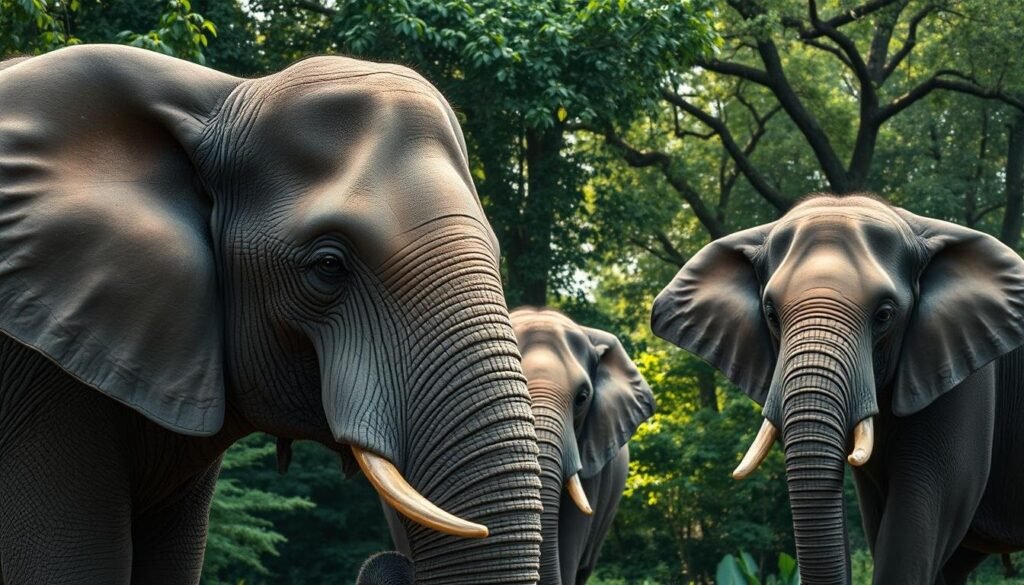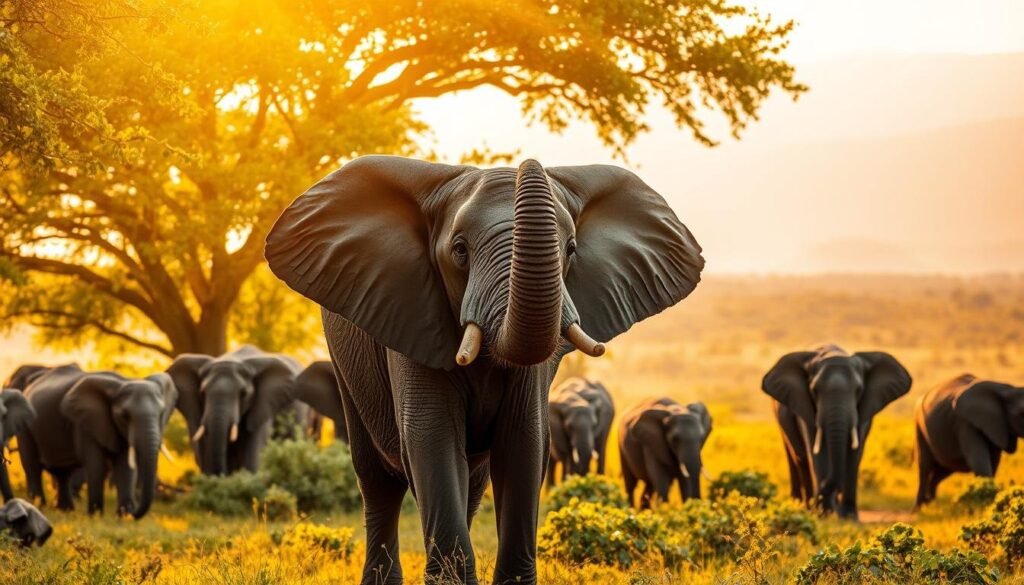Why Do Elephants Flap Their Ears Constantly? Have you ever wondered why an elephant’s ears move all the time? It’s not just a habit. It’s linked to their unique anatomy and has many uses.
Learning about elephant behavior and elephant anatomy helps us understand their ear flapping. Their big ears do more than look impressive. They help control their body temperature and talk to other elephants.
As you learn more, you’ll see how elephants use their ears to stay alive and do well in their world.
Contents
- 1 The Remarkable Anatomy of Elephant Ears
- 2 Why Do Elephants Flap Their Ears Constantly?
- 3 Communication Through Ear Movements
- 4 African vs. Asian Elephants: Differences in Ear Flapping
- 5 Research and Observations on Elephant Ear Behavior
- 6 Conclusion: Why Do Elephants Flap Their Ears Constantly?
- 7 FAQ
- 7.1 Why do elephants flap their ears?
- 7.2 How do elephant ears help with thermoregulation?
- 7.3 Do African and Asian elephants flap their ears differently?
- 7.4 What role do ear movements play in elephant communication?
- 7.5 How do researchers study elephant ear behavior?
- 7.6 What can we learn from the differences in ear flapping between African and Asian elephants?
- 7.7 Why is it important to understand elephant ear behavior?
The Remarkable Anatomy of Elephant Ears
The ears of an elephant are a remarkable example of evolutionary adaptation. They play a crucial role in regulating body temperature and communication.
Elephant ears have a complex network of blood vessels for heat dissipation. They are large and flat, capturing and releasing heat efficiently. This structure is vital for maintaining body temperature, especially in hot climates.
The anatomy of an elephant’s ear is not just about temperature regulation. It also plays a significant role in communication. Elephants use their ears to convey emotions and signals to other elephants. For instance, flapping their ears can signal excitement or warning.
Understanding the elephant ear function is essential to appreciating the complexity of elephant behavior. The ears are a vital part of their elephant anatomy. They contribute significantly to their survival and social interactions.
In summary, the remarkable anatomy of elephant ears is a testament to the incredible adaptability of elephants. Their ears are a crucial aspect of their physiology. They enable elephants to thrive in various environments.
Why Do Elephants Flap Their Ears Constantly?
Elephants live in many places, from deserts to forests. Their big ears help them adapt to these environments. The ears have lots of blood vessels close to the surface. This makes them great for keeping the body temperature right.
Cooling Mechanism
When elephants flap their ears, it cools them down. They do this by making blood flow more in their ears. This blood gets cooled by the flapping and then spreads throughout the body.
This helps lower the body’s temperature. It’s very important for elephants in hot places where it gets really hot during the day.
The table below summarizes the key aspects of how elephants use their ears for thermoregulation:
| Mechanism | Description | Benefit |
|---|---|---|
| Ear Flapping | Increases blood flow through the ears | Cools the blood |
| Blood Circulation | Cooled blood is circulated throughout the body | Lowers body temperature |
| Adaptation | Helps elephants adapt to hot climates | Enhances survival chances |
Ear flapping can also show how an elephant feels or be a way to talk. But, the main reason is to keep their body temperature stable.
Learning about elephants’ ear flapping helps us understand their amazing ability to adapt. It shows how they can live well in many different places.
Communication Through Ear Movements
The way an elephant moves its ears is key to its non-verbal talk. It shows how they feel and what they want. When they’re excited, scared, or trying to say something, their ears help a lot.
Elephants use their ears to send many messages. They can show anger, warn others, or be friendly. How they hold their ears tells others how they’re feeling and what they plan to do.
For example, if an elephant feels angry or scared, it spreads its ears wide. This makes it look bigger and warns others. But if it’s feeling calm or friendly, it keeps its ears relaxed. This shows it’s open to meeting others.
Ear Positions and Their Meanings
| Ear Position | Meaning |
|---|---|
| Ears spread wide | Aggression or warning signal |
| Ears held back | Submission or fear |
| Ears in a relaxed position | Friendliness or approachability |
Knowing these non-verbal cues helps us understand elephants better. By watching their ear movements, we can learn about their behavior and how they live together.
In short, how elephants talk through ear movements is really interesting. By understanding these signals, we can learn more about these smart animals and their complex social lives.
African vs. Asian Elephants: Differences in Ear Flapping
The way African and Asian elephants flap their ears shows how they adapt to their surroundings. These differences are not just in how often they flap their ears. They also show in the shape of their ears.
African elephants have bigger ears than Asian elephants. These bigger ears help them stay cool and hear better. The size and shape allow for more efficient heat dissipation, which is vital in their savanna and forest habitats.

Asian elephants have smaller, more rounded ears. This is because they live in warmer, more humid places. They don’t need to cool down as much as African elephants do.
African elephants flap their ears more often. This helps them cool down and is a way to communicate. Asian elephants flap their ears less, showing their different social and environmental settings.
| Characteristics | African Elephants | Asian Elephants |
|---|---|---|
| Ear Size | Larger | Smaller |
| Ear Shape | More fan-shaped | More rounded |
| Ear Flapping Frequency | Higher | Lower |
Learning about the differences in ear anatomy and behavior between African and Asian elephants is important. It shows their unique adaptations and the need for conservation efforts that meet each species’ specific needs.
Research and Observations on Elephant Ear Behavior
Studies on elephant behavior show how important ear flapping is. It helps them communicate and stay cool. By watching elephants in the wild, scientists learn a lot about their social lives and how they talk to each other.
Researchers have looked into why elephants flap their ears so much. They found that it’s not just a simple action. It helps them control their body temperature and shows how they feel.
It’s also interesting to see how different elephants flap their ears. African elephants flap theirs more than Asian elephants. This might be because of where they live and the weather they face.
| Aspect | African Elephants | Asian Elephants |
|---|---|---|
| Ear Size | Larger ears | Smaller ears |
| Ear Flapping Frequency | More frequent | Less frequent |
| Habitat | Savannas and forests | Forests and grasslands |
Knowing these differences helps us protect elephants better. It also shows how complex their behavior is. As scientists keep studying, we’ll learn even more about elephant ear behavior and its role in their lives.
Conclusion: Why Do Elephants Flap Their Ears Constantly?
You now know why elephants flap their ears so much. This behavior is linked to their body structure, keeping cool, and talking to each other. The way elephants use their ears is key to staying comfortable and connecting with others.
Looking at African and Asian elephants shows us how they communicate through ear movements. This helps us understand how vital ear flapping is in their social lives.
Reflecting on elephants’ anatomy and behavior can deepen our respect for them. We see how special they are and how important they are to their environments.
See Also: Why Lemurs Sunbathe with Arms Spread Wide?
FAQ
Why do elephants flap their ears?
Elephants flap their ears to keep cool, talk to each other, and show feelings.
How do elephant ears help with thermoregulation?
Elephant ears have blood vessels that help cool the blood. This cools the body.
Do African and Asian elephants flap their ears differently?
Yes, they do. African and Asian elephants have different ear shapes and sizes. They flap their ears in unique ways, showing their special adaptations.
What role do ear movements play in elephant communication?
Ear movements help elephants show if they are angry, friendly, or warning others. It’s key for their social bonds and interactions.
How do researchers study elephant ear behavior?
Researchers watch elephants in the wild. They learn about their social lives, how they talk, and how they adapt.
What can we learn from the differences in ear flapping between African and Asian elephants?
By studying these differences, we gain insights into their evolution and how they live in different places.
Why is it important to understand elephant ear behavior?
Knowing about elephant ear behavior helps us value these animals. It also guides efforts to protect them.

Zyair Larson, based in Denver, Colorado, has over 12 years of experience studying animal behavior. He has worked with the World Wildlife Fund (WWF) and National Geographic, researching wildlife and sharing insights on animal habits globally.

